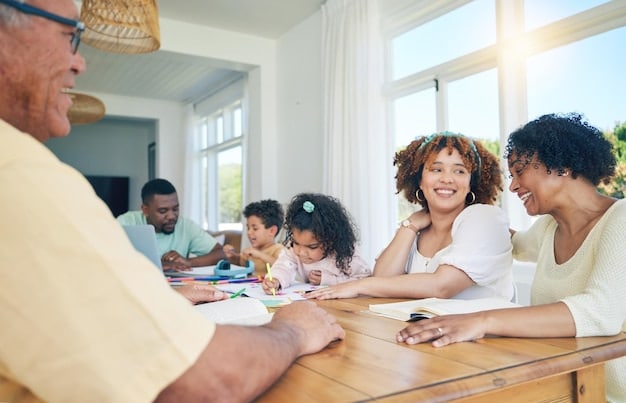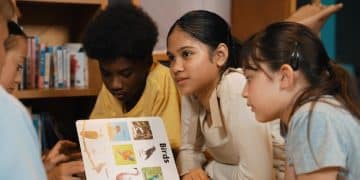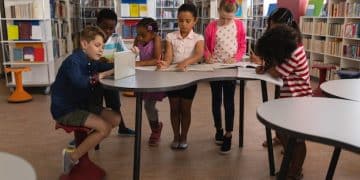Effective Communication Strategies for Educators to Connect with Parents and Guardians

Anúncios
Effectively communicating with parents and guardians involves creating open, respectful dialogues that support student success by using clear language, active listening, and timely updates to foster trust and collaboration.
In today’s educational landscape, the ability to effectively communicate with parents and guardians is paramount. Bridging the gap between home and school cultivates a supportive environment where students can thrive academically, socially, and emotionally.
Anúncios
Why Effective Communication Matters
Effective communication between educators and parents/guardians is not merely a procedural formality but the cornerstone of a successful educational journey for students. This communication forms a network of support, trust, and understanding that significantly impacts a child’s overall development.
Building a Strong Support System
When teachers and parents consistently share information and insights, they jointly create a robust support system for the student. This system is vital for identifying and addressing academic or behavioral challenges early on.
Anúncios
Enhancing Student Outcomes
Research consistently shows that students benefit academically when their parents are actively involved in their education. Effective communication fosters this involvement, which, in turn, leads to better grades, higher attendance rates, and increased motivation.

Here are some ways how communication enhances student outcomes:
- Academic Performance: Regular communication allows parents to stay informed about their child’s progress and challenges, enabling them to provide targeted support at home.
- Behavioral Improvements: When teachers and parents collaborate, they can implement consistent strategies to address behavioral issues, leading to a more disciplined and focused learning environment.
- Emotional Well-being: Open communication helps students feel supported and valued, reducing anxiety and promoting a positive attitude towards learning.
In summary, promoting effective communication is not only beneficial but essential for nurturing a well-rounded, successful learning environment for every child.
Establishing Open Communication Channels
To ensure information flows smoothly and efficiently, it’s critical to establish various open communication channels. Each conduit has its unique advantages and should be tailored to accommodate the diverse needs and preferences of parents and guardians.
Email as a Primary Tool
Email remains one of the most widely used and effective tools for regular updates and detailed communication. Teachers can use email to share progress reports, upcoming events, and specific concerns or praise regarding a student’s performance.
Utilizing Digital Platforms
Many schools now employ digital platforms or apps designed to streamline communication. These platforms often offer features like real-time notifications, shared calendars, and secure messaging.
Effective communication requires the implementation of various techniques:
- Classroom Newsletters: Send out weekly or monthly newsletters summarizing classroom activities, learning objectives, and important dates.
- Parent-Teacher Conferences: Schedule regular meetings to discuss student progress, challenges, and strategies for improvement.
- Phone Calls and Text Messages: Use phone calls or text messages for quick updates or urgent matters.
Establishing and maintaining diverse communication channels ensures that all parents and guardians can stay informed and engaged in their child’s education, regardless of their schedules or preferences.
Active Listening and Empathy
Effective communication involves not only the transmission of information but also the reception and understanding of it. Active listening and empathy are crucial in fostering a positive and productive dialogue between educators and parents/guardians.
The Importance of Active Listening
Active listening means fully concentrating on what the other person is saying, understanding their perspective, and responding thoughtfully. This approach can significantly enhance understanding and build trust.
Showing Empathy in Conversations
Empathy involves recognizing and sharing the feelings of others. When communicating with parents, showing empathy can help them feel understood and valued. This can be achieved through verbal cues, such as acknowledging their concerns, and non-verbal cues, such as maintaining eye contact and nodding.

These are impactful methods to improve listening and demonstrate empathy:
- Paraphrase: Summarize what the person has said to ensure you understand correctly.
- Ask Clarifying Questions: Encourage deeper understanding by asking open-ended questions.
- Validate Emotions: Acknowledge the feelings of the speaker to show you understand their emotional state.
By prioritizing active listening and empathy, educators can create meaningful interactions that build strong relationships with parents and guardians, which, in turn, support student success.
Providing Constructive Feedback
Feedback is a vital component of effective communication, particularly in an educational context. It helps parents and guardians understand their child’s strengths and areas for improvement, fostering a collaborative approach to learning and development.
Balancing Positive and Negative Feedback
When providing feedback, it’s essential to strike a balance between positive reinforcement and constructive criticism. Highlighting a student’s achievements and strengths can boost their confidence and motivation, while addressing areas for improvement helps them grow and develop.
Using Specific Examples
Vague feedback can be ineffective and confusing. Instead, use specific examples from classroom observations, assignments, or assessments to illustrate your points. This provides parents with a clear understanding of their child’s performance and progress.
To summarize, constructive feedback should be actionable, timely, and focused on helping the student improve:
- Focus on Behavior: Frame your feedback around specific behaviors or actions, rather than making generalizations about the student’s character.
- Offer Solutions: Suggest practical strategies or resources that parents and students can use to address challenges.
- Encourage Dialogue: Invite parents to share their perspectives and work collaboratively to develop a plan for improvement.
Providing constructive feedback is an integral part of fostering a strong home-school partnership, leading to improved student outcomes and a more supportive learning environment.
Addressing Conflicts and Concerns
Conflicts and concerns are virtually unavoidable in any collaborative relationship, and the partnership between educators and parents/guardians is no exception. Addressing these issues promptly, respectfully, and effectively is essential for maintaining a positive learning environment.
Establishing Protocols for Conflict Resolution
Schools should have established protocols for addressing conflicts and concerns. These protocols should be clearly communicated to parents and guardians, outlining the steps they can take to voice their concerns and seek resolution.
Maintaining a Respectful Tone
When addressing conflicts, it’s crucial to maintain a respectful and professional tone. Even when disagreements arise, it’s important to listen to the other person’s perspective, acknowledge their concerns, and work collaboratively to find a mutually acceptable solution.
Some communication techniques that assist in resolving concerns:
- Schedule a Meeting : Arrange a face-to-face meeting or phone call to discuss the issue in a private setting.
- Stay Calm: Remain calm and composed, even if the conversation becomes heated.
- Document Everything: Keep a record of all communications, including dates, times, and key points discussed.
Effectively addressing conflicts and concerns is crucial for building trust and maintaining a positive relationship between educators and parents/guardians, ensuring a supportive learning environment for students.
Cultural Sensitivity and Inclusivity
In today’s diverse educational landscape, cultural sensitivity and inclusivity are paramount. Recognizing and respecting the cultural backgrounds, values, and beliefs of all students and families is essential for creating an inclusive and equitable learning environment.
Understanding Diverse Backgrounds
Educators should strive to understand the diverse cultural backgrounds of their students and families. This includes recognizing differences in communication styles, family structures, and educational expectations.
Translating Materials and Providing Interpreters
To ensure all parents and guardians have access to important information, schools should provide materials in multiple languages and offer interpreters for meetings and conferences. This can help bridge communication gaps and ensure that all families are fully informed and engaged.
Here are key actions that help with cultural sensitivity and inclusive practices:
- Learn About Different Cultures: Educate yourself about the cultural backgrounds of your students and families.
- Avoid Stereotypes: Be mindful of stereotypes and assumptions, and treat each individual as an individual.
- Create a Welcoming Environment: Make your classroom or school environment welcoming and inclusive for all students and families.
By promoting cultural sensitivity and inclusivity, can create a supportive and equitable learning environment where all students and families feel valued, respected, and empowered to succeed.
| Key Aspect | Brief Description |
|---|---|
| 📣 Open Channels | Use email, portals, and newsletters for frequent updates. |
| 👂 Active Listening | Show empathy and listen actively to parents’ concerns. |
| ✅ Constructive Feedback | Balance praise with specific areas for improvement. |
| 🌍 Cultural Sensitivity | Respect diverse backgrounds and communication styles. |
Frequently Asked Questions (FAQ)
▼
Parent-teacher communication is vital because it fosters a supportive environment where students can thrive academically, socially, and emotionally. It helps align efforts and create a unified approach towards the student’s development.
▼
Effective methods include email updates, classroom newsletters, scheduled parent-teacher conferences, and quick phone calls or text messages for urgent matters. Digital platforms streamline these interactions, offering real-time updates.
▼
Teachers can demonstrate empathy by actively listening, paraphrasing parents’ concerns, asking clarifying questions, and validating their emotions. Showing genuine understanding strengthens relationships and builds trust between home and school.
▼
Constructive feedback should balance positive comments with specific improvement areas, use specific examples, focus on behavior, offer actionable solutions, and encourage open dialogue. This helps create a clear path for student progress.
▼
Schools should establish clear conflict resolution protocols, maintain a respectful tone, schedule private discussions, and document everything to ensure fair and professional handling of disputes. This approach builds trust and preserves relationships.
Conclusion
Effectively communicating with parents and guardians is a continuous process that requires dedication, empathy, and a commitment to creating strong partnerships that benefit the student. By applying the strategies discussed, educators can build bridges between home and school, fostering a supportive and collaborative environment where every child can thrive.





